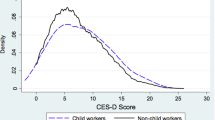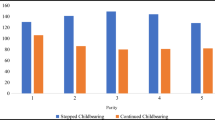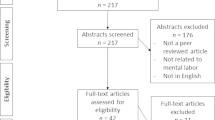Abstract
We study the effect of the expansion of the mandatory paid maternity leave, implemented in Switzerland in 2005, on individuals’ fertility intentions. Earlier literature found evidence of fertility increases induced by maternity leave expansions from other countries of a relatively large magnitude of 1 year. The expansion that we consider was smaller, from 8 unpaid weeks to 14 mandatory paid weeks, and thus its effect on fertility decisions is less evident ex ante. Nevertheless, we find that it positively impacts fertility planning even though, by construction, our model specification cannot capture its full effect. The strongest effects are elicited in the subsamples of men, individuals with two children, and individuals aged between 31 and 36. There are several channels through which the maternity leave expansion may affect individuals’ child planning, all indicative of a positive effect on the fertility rate.
Similar content being viewed by others
Notes
While cost considerations, particularly to private enterprises, play a secondary role in the public debate surrounding the topic of maternity leave extensions from European countries, they are the main consideration in the corresponding debate in the United States, where concerns about the national fertility rate are currently less serious (Averett and Wittington 2001).
Some individuals benefited from a paid maternity leave as generous as the one implemented by the policy reform even before 2005, either because their employers offered them voluntarily, or because they lived in the Bern canton which was mandating these more generous benefits even before 2005 (the dataset we employ does not allow identifying either of these two categories of individuals, and therefore they cannot be used as a control group). Our analysis thus elicits intended-to-treat effects.
The new maternity leave policy did not apply to mothers residing in Bern since their prior benefits were more generous. They also did not actually provide benefits to new mothers working for employers that had been offering benefits who were at least as generous as the mandatory minimum levels before July 1st, 2005. Since the observations in our dataset do not have geographical information, we cannot use individuals from the Bern canton as a control group.
At the time of the policy change in 2005, most cantons did not set a universal ceiling on the payments. The exception was canton Thurgau, which set a ceiling of CHF172/day (https://www.swissinfo.ch/eng/maternity-benefit-finally-sees-light-of-day/8578). Currently, a universal ceiling of CHF196/day is in place everywhere. The resulting average payment rate in 2016 was 56.4% of the mother’s previous earnings (OECD 2017b).
The new maternity leave benefits that were to be offered starting with July 1st, 2005 were announced on November 24th, 2004. Women who gave birth to children between the date of the announcement and July 1st, 2015 were eligible to claim the paid maternity leave starting with July 1st, 2005 (https://www.swissinfo.ch/eng/maternity-benefit-to-become-reality-from-july/4215604) but only for the remaining number of weeks up to 14 from the day of the birth. For instance, a mother who gave birth to a child 2 weeks before July 1st, was eligible for only the 12 weeks of paid maternity leave instead of 14. Thus, women who gave birth to children after April 1st, 2005 experienced these expanded benefits, at least partially, provided that their employer had not offered them before the reform. To obtain a larger treatment group, we included the respondents who had a child in 2005 in the analysis, at the expense of having the key coefficient potentially biased towards zero.
See, for instance, page 6 in OECD (2017c).
This could be explained by the fact that women tend to have children earlier in life than men since in the typical couple, the woman is younger. In the fixed age bracket that we consider, a person with a child is thus more likely to be a woman, whereas one without is more likely to be a man. Another possible explanation is that men answered that they do not have a child if they did not have custody of their children, which in a case of separation of parents is predominantly the case.
CHF denotes Swiss franc.
A possible explanation for this fact is that some of the individuals from this age group made a child after the reform was implemented, induced by its expanded MB, and then completed their fertility (we consider this channel in the discussion section where we analyze the possible channels that can drive the key results of our analysis). Such an effect would reduce the likelihood that this group would plan a higher order child in the future, explaining the negative coefficient in the regression. Nevertheless, as argued earlier, if this is the explanation for the negative coefficient, it is likely that the overall effect on the fertility rate is positive in this age group as well because earlier births reduce the impact of unexpected negative shocks to fertility.
An intuitive explanation is as follows. Shifting an individual from the subset of individuals of the control group who would have responded in 2010 that they plan a child into the subset of individuals from the treatment group who respond in 2010 that they do not plan a child decreases the probabilities that the individuals from both the treatment and the control group respond in 2010 that they plan an additional child. It can be shown mathematically that it would decrease this probability more in the control group if the number of individuals from the control group who respond that they plan to have a child is smaller than the number of individuals from the control group who respond that they do not plan a child.
References
Ang, X. (2014). The effects of cash transfer fertility incentives and parental leave benefits on fertility and labor supply: Evidence from two natural experiments. Journal of Family and Economic Issues, 36(2), 263–288. https://doi.org/10.1007/s10834-014-9394-3.
Averett, S. L., & Whittington, L. A. (2001). Does maternity leave induce births?. Southern Economic Journal, 68(2), 403–417. Retrieved from http://www.jstor.org/stable/1061601/.
Bassford, M., & Fisher, H. (2016). Bonus babies? The impact of paid parental leave on fertility intentions. Sydney: Institute for Social Science Research. Retrieved from http://www.lifecoursecentre.org.au/working-papers/bonus-babies-the-impact-of-paid-parental-leave-on-fertility-intentions/.
Berrington, A. (2004). Perpetual postponers? Women’s, mens and couples fertility intentions and subsequent fertility behavior. Population Trends, 117, 9–19.
Buckles, K. S., & Munnich, E. L. (2012). Birth spacing and sibling outcomes. Journal of Human Resources, 47, 613–642.
Cannonier, C. (2014). Does the family and medical leave act (FMLA) increase fertility behavior? Journal of Labor Research, 35, 105–132. https://doi.org/10.1007/s12122-014-9181-9.
Cohen, A., Dehejia, R., & Romanov, D. (2013). Financial incentives and fertility. Review of Economics and Statistics, 95(1), 1–20. https://doi.org/10.1162/REST_a_00342.
Cygan-Rehm, K. (2016). Parental leave benefit and differential fertility responses: Evidence from a German reform. Journal of Population Economics, 29(1), 73–103. https://doi.org/10.1007/s00148-015-0562-z.
Gough, M. (2017). Birth spacing, human capital, and the motherhood penalty in midlife in the United States. Demographic Research, 37, 363–416. https://doi.org/10.4054/DemRes.2017.37.13.
Hill, E. L., & Slusky, D. J. G. (2017). Birth spacing and educational outcomes. Advances in Health Economics and Health Services Research, 25. https://doi.org/10.1108/S0731-219920170000025001.
Karimi, A. (2014). The spacing of births and women’s subsequent earnings – evidence from a natural experiment. Uppsala: Institute for Evaluation of Labour Market and Education Policy. Retrieved from http://www.ifau.se/globalassets/pdf/se/2014/wp2014-18-the-spacing-of-births-and-womens-subsequent-earnings.pdf/.
Lalive, R., & Zweimuller, J. (2009). How does parental leave affect fertility and return to work? evidence from two natural experiments. The Quarterly Journal of Economics, 124(3), 1363–1402. https://doi.org/10.1162/qjec.2009.124.3.1363.
Malkova, O. (2017). Can maternity benefits have long-term effects on childbearing? evidence from Soviet Russia. Review of Economics and Statistics. https://doi.org/10.1162/rest_a_00713.
Maternity Leave Finally Sees Light in the Day. (2005). In Swiss Info. Retrieved from http://www.swissinfo.ch/eng/maternity-benefit-finally-sees-light-of-day/8578/.
Milligan, K. (2005). Subsidizing the Stork: New Evidence on Tax Incentives and Fertility. Review of Economics and Statistics, 87, 539–555. https://doi.org/10.1162/0034653054638382.
Morgan, S. (2001). Should fertility intentions inform fertility forecasts? The direction of the fertility in the United States. Washington DC: US Census Bureau. Retrieved from http://www.copafs.org/UserFiles/file/reports/The%20Direction%20of%20Fertility%20in%20the%20United%20States.pdf#page=165/.
OECD. (2017a). SF2.1: Fertility rates. Retrieved from http://www.oecd.org/els/family/SF_2_1_Fertility_rates.pdf/.
OECD. (2017b). PF2.1: Key characteristics of parental leave systems. Retrieved from http://www.oecd.org/els/soc/PF2_1_Parental_leave_systems.pdf/.
OECD. (2017c). SF2.3: Age of mothers at childbirth and age-specific fertility. Retrieved from http://www.oecd.org/els/soc/SF_2_3_Age_mothers_childbirth.pdf/.
Pettersson-Lidbom, P., & Thoursie, P. S. (2009). Does child spacing affect children’s outcomes? Evidence from a Swedish reform. Uppsala: Institute for Labour Market Policy Evaluation. Retrieved from http://www.econstor.eu/bitstream/10419/45740/1/597621721.pdf/.
Ray, R. (2008). A detailed look at parental leave policies in 21 OECD Countries. Center for Economic and Policy Research. Retrieved from http://www.lisdatacenter.org/wp-content/uploads/parent-leave-details1.pdf/.
Schoen, R., Astone, N. M., Kim, Y. J., Nathanson, C. A., & Fields, J. M. (1999). Do fertility intentions affect fertility behavior? Journal of Marriage and the Family, 61, 790–799. https://doi.org/10.2307/353578.
Acknowledgements
We thank helpful comments from Padmaja Ayyagari, Giulia La Mattina, and Joshua Wilde.
Author information
Authors and Affiliations
Corresponding authors
Ethics declarations
Conflict of interest
Andrei Barbos declares that he has no conflict of interest, Stefani Milovanska-Farrington declares that she has no conflict of interest.
Ethical Approval
This article does not contain any studies with human participants or animals performed by any of the authors.
Additional information
Publisher’s Note
Springer Nature remains neutral with regard to jurisdictional claims in published maps and institutional affiliations.
Appendix
Rights and permissions
About this article
Cite this article
Barbos, A., Milovanska-Farrington, S. The Effect of Maternity Leave Expansions on Fertility Intentions: Evidence from Switzerland. J Fam Econ Iss 40, 323–337 (2019). https://doi.org/10.1007/s10834-019-09609-3
Published:
Issue Date:
DOI: https://doi.org/10.1007/s10834-019-09609-3




